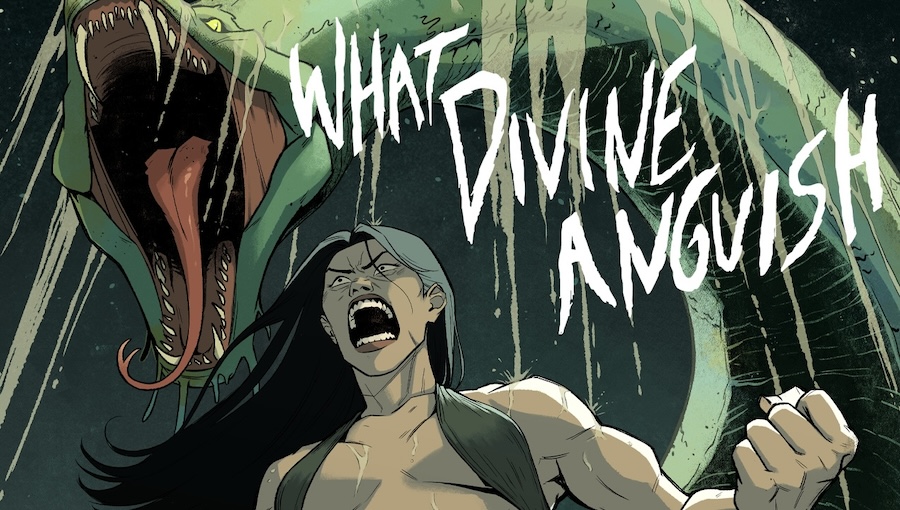The following is an interview with Kim Jung-ho on the upcoming release of the sci-fi/horror comic book anthology, What Divine Anguish, through publisher Martian Sun. In this interview, Fanbase Press Editor-in-Chief Barbra Dillon chats with Jung-ho about the shared creative process of crafting a complementary collection of stories, what readers may take away from the stories’ themes, and more!
Barbra Dillon, Fanbase Press Editor-in-Chief: Congratulations on the upcoming release of What Divine Anguish! For those who may be unfamiliar, what can you tell us about the premise of this collection?
Kim Jung-ho: Thank you so much for the opportunity to introduce What Divine Anguish. It’s a collection of short sci-fi/horror comics, driven by what-if questions with usually unfortunate answers for their “heroes.” The opening story is entitled “Other Fish,” about a heartbroken college student who realizes a jealous desire for self-improvement by replacing parts of his body with those of other people’s, certainly without their permission. “What if I could be better?” for one is “What if my ex-boyfriend was a body horror nightmare?” for another.
BD: How would you describe the process for bringing the various creators together, as well as the thematic approach to crafting a complementary collection of stories?
KJ: It was a learning experience, for sure. I didn’t even know where to start with reaching out to artists. When I was younger, there were dedicated forums where writers could post jobs, and today, everything’s social media, which has pros and cons. It’s probably easier for opportunists, and I certainly had my run-ins, but dealing with actual people for the first time – asking them to spend time on things I’d written – I didn’t want to post publicly and have to say no to anyone. On Facebook, for example, I could message someone directly, and primarily what I was looking for was eye-catching styles. I wanted each story to have a unique art style, colors, and so on, as I believe they’re unique tales. Both “Profane Worship” and “Attack of the Snake Men,” for example, have similar imagery, taking place in fantasy worlds, but have opposite tones. Ichsan Ansori’s colors for “Profane” are dark and moody, while Iacopo Calisti’s art for “Snake Men” is subtly cartoony.
Similarly, “The Worldwife” and “Revenant Lane” are about human-like robots, but they take place in different time periods. I looked to artist Alex Guenther for both titles, and he applied two approaches. Further, for “Revenant Lane,” which takes place in the 1950s, I asked colorist Stella Elisa Cassinese to reference retro magazines like Popular Mechanics. This was probably the only way to justify including both in one collection, because they are so similar, but they also form part of a thematic sequence. So, many of the collected titles – and I wasn’t fully conscious of this in the writing – are about the permissions we give ourselves to do immoral things, and the mental processes of getting there. That, specifically, is the “what-if” explored in What Divine Anguish which was a bit upsetting to realize.
BD: The collection is being published through Martian Sun. What makes the publisher the perfect home for this anthology?
KJ: At the moment, Martian Sun is a publisher in name only. It’s just me, trying to establish a dedicated, independent platform for sci-fi/horror comics. And related genres, I should say. As mentioned, there are fantasy stories in this collection, as well as one where part of the reveal is the absence of a supernatural element. I’m hoping Martian Sun can be a home for storytelling which expresses the mindset behind these genres: the curiosity about our very curious world, and the willingness to exercise that curiosity with, you know, monsters and robots and giant women who come out of the sea to tear people apart.
BD: At Fanbase Press, our #StoriesMatter initiative endeavors to highlight the impact that stories can have on audiences of various mediums. How do you feel that these stories may connect with and impact readers?
KJ: As these stories are often about the decision-making behind immoral acts, they are also then interested in disruptions to the moral order. Fiction, and science fiction especially, is a safe space to imagine alternate scenarios, whether for our lives, our governments, our technologies. It’s my hope that What Divine Anguish inspires readers to validate the voice in their heads that prickles whenever something feels off in the world. Not to be full-blown conspiracy theorists, as part of living in a functional society is accepting certain tenets uncritically, but we know that seedy elements take advantage of that. Corporations, politicians, your boss – they have higher priorities than your well-being. I’m fascinated by how a person rationalizes the shuffling of those priorities, and hopefully, the result for the reader is pattern recognition for identifying those behaviors in the real world.
BD: Are there any other projects that you would like to share with readers?
KJ: Scripts in hand, I’m ready to continue with short comics, but I’m also interested in longer stories. There’s one tentatively titled “One of Us is a Robot,” about high schoolers who come to believe that one of them is – well, I won’t give it away.
BD: Lastly, what would you like to tell fans who want to learn more about What Divine Anguish?
KJ: What Divine Anguish makes for a lovely paperback volume, which will be available in June; however, all nine of its stories are available to read for free on the publisher’s website, MartianSunMagazine.com. There’s also the digital edition, which you can find on Gumroad.
Thank you again for taking the time to speak with me. Along with #StoriesMatter, I think Fanbase Press is such a positive force in the comic world, spotlighting creators even as tiny as me!

